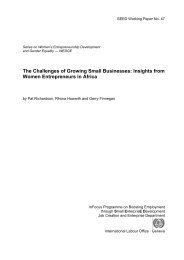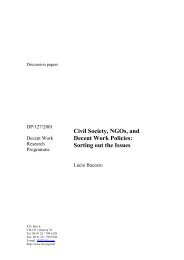manual: women workers' rights and gender equality - International ...
manual: women workers' rights and gender equality - International ...
manual: women workers' rights and gender equality - International ...
Create successful ePaper yourself
Turn your PDF publications into a flip-book with our unique Google optimized e-Paper software.
Exercise<br />
Step 1<br />
• Divide the participants into four groups: one group in each corner of the room<br />
• Give each group a paper with the activities <strong>and</strong> a paper with the man, woman <strong>and</strong> couple<br />
• Ask the groups to cut the paper with activities/situations into separate pieces (this can also be<br />
done before the session)<br />
• The same should be done with the page with the drawings of the man, woman <strong>and</strong> couple<br />
• Explain that the activities/situations are taken from just a day of a rural family<br />
• Ask the groups to place all activities/situations under the 3 cards. The activities usually done<br />
by <strong>women</strong> under the card with the woman, the activities usually done by men under the man<br />
<strong>and</strong> those activities done by both sexes should be placed under the couple<br />
Step 2<br />
• Discuss the results using the following questions:<br />
- Under which card are most activity cards: the woman, man or couple?<br />
- Is this the same in all groups?<br />
- If yes, why?<br />
- Who do they think makes longer workdays?<br />
- What are the reasons for this?<br />
- What is the main workplace of <strong>women</strong> <strong>and</strong> of men?<br />
- What do they think of this situation?<br />
Step 3<br />
• Summarize the division of work; most probably the number of cards placed under the woman<br />
is longest because she gets all household related activities. As a result her working day will be<br />
longer<br />
Step 4<br />
• The activity cards placed in this way are needed for the second <strong>and</strong> third session on the<br />
division of work. Put a red cross on all activity cards under the man, a green cross on the cards<br />
under the woman <strong>and</strong> a yellow cross on the cards under the couple<br />
Notes for the trainer<br />
In this session a distinction is made between activities from which an income can be generated,<br />
activities done in leisure time <strong>and</strong> household activities. Since the largest share of the activity <strong>and</strong><br />
situation cards show household activities, most probably the number of cards placed under the<br />
woman is much larger than under the man. This shows clearly the division of work as it is in a large<br />
number of households around the world.<br />
Points for the summary<br />
Despite the very considerable differences in daily live of different groups usually the outcome will be:<br />
- Men <strong>and</strong> <strong>women</strong> do different things during the day<br />
- Women usually work more hours<br />
- Women have more varied tasks, <strong>and</strong> sometimes do more than one thing at the same time (like:<br />
looking after the kids <strong>and</strong> preparing a meal or doing the laundry)<br />
- Women do more work for the family<br />
- Men have more leisure time<br />
- Women have less sleep<br />
34

















